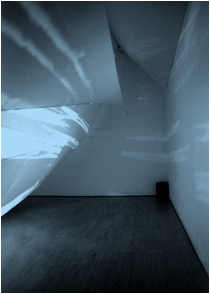
Bragança
de Miranda
Machine: The Funcional Impossibility
Carrilho da Graça
Performance (Interview)
Diller + Scofidio
Jump Cuts
Hani Rashid
The diference-Scape: The Digital Machine
Neil Denari
Interruped Projections
Rui Tavares
Seapking of Miguel Palma
Santa-Rita
The Mechanical Flirt
Machine: The Funcional Impossibility
Carrilho da Graça
Performance (Interview)
Diller + Scofidio
Jump Cuts
Hani Rashid
The diference-Scape: The Digital Machine
Neil Denari
Interruped Projections
Rui Tavares
Seapking of Miguel Palma
Santa-Rita
The Mechanical Flirt





"The Diference-Scape: The Digital Machine"
New york 1998
In relation to architectural and spatial practices the use of digital technologies posits a number of interesting questions regarding notions of utility, conceptual artifice and representation. Even if we think of the computer as a "neutral" tool embedded into the complex procedures of design it is essentially still capable of dismantling our conventional modalities of making, reading, writing, communicating and inevitably comprehending. Digital technologies, themselves being the foundation of computing, the web, the mass media, and a vast array of other so called "advances" is no less a tool of expression and form-giver to desire(s) as it is a socio-political instrument. Another entirely different view might suggest that the digital is bringing on a new landscape delineated by those who have access and those who don´t. One group embracing the twenty first century while another dangerously becoming a new underclass. The digital machine makes it possible to operate simultaneously on infinite scales and meaning. One of which is an idea of community which is based entirely on the scope of our access to information. We strive to be simultaneously "located" within and "dislocated" from a "community" through the digital interfaces we are conjuring, and yet interaction and by extension perception is now perpetually in a state of flux where the only dominant landscape is one of difference.
It is ironic that the prospect of community on such a large scale (where cultural boundaries are physically erased) is more often than not accompanied by an attempted erasure of cultural identity. In the end however emphasis is not necessarily placed on the common ground shared by these diverse factions, but provides the opportunity for deciphering precisely the opposite. For instance through a reading of a given culture´s misappropriations of another one, it is actually possible that one could begin to measure difference. A good example of this is Japan´s sense of its own cultural and iconographic makeup as a mediated reflection of American and Western European pop culture. Elvis, Marilyn, Superman, Tin Tin and the like are all iconography assemblies absorbed, reworked and distributed globally in various forms and embodiments ranging from Manga Anime to Bullet Trains. The icons that make up this new landscape of difference are essentially mediated reflexes of similitude and diversification. Constructs which are mirrored endlessly over computer networks, "home-pages", televised imagery, advertising campaigns and the like. In contrast the notion of modernity that emerged from pre and post war Western Europe called for a fabricated perfection, instigated in part from a obsessive interest in hygiene, homogeneity and the relentless exports of idealism.
The International Style in architectural and design venues was also perfectly engineered and in much the same manner a marketing strategy. Today the hysteria and propaganda that heralds the Web as a utopian force has some remarkable similarities to our preceding optimism and belief in modernity. The Web is being peddled as a place where we are all happily plugged-in, where individuals will have complete and uncensored access to all information. These "utopian" communities will exist on the fringes providing ability to access goods, thoughts, sex, news, lifestyles and all desires. It too is a hygienic, pristine, open and free terrain for all those with an access code. Millions are able to meander freely pursuing their every whim. And all this is ostensibly without censorship, persecution, fears of reprisal or confinement of any sort. A veritable melting pot for a new humanity, the communal farm without the sweat, the absolute vacation without the trouble.
The digital machine in all of its incarnations must therefore be defined within the space of control, where software is a 'pre-determining' agent and conversely the renegade spirit is effectively procedural. Ultimately the potential that belies the digital machine is that no matter how entrenched in our daily lives it becomes, it will never be entirely familiar. The distance that the electro-sphere has to us will always be an immense chasm. This impossibility of dominance over this newly manufactured nature, of understanding the lapses and gaps it entails, is perhaps where the most potential lies for new entities which are now only beginning to surface.
As you enact a key-stroke, a signal goes off somewhere, and in that transmission there is infinite potential - events happen in-between space, time and distance. This is similar to those ancient ships appearing on a distant horizon imbued with goods, people and above all knowledge. Architecture could be seen this way, too - not just through its formal principles but by its implicit condition as a text of sorts that can interpret and attempt to make sense of the landscape and territories it occupies and forms. The inscriptions we make as architects should be about the human aspiration towards the unknown, manifest most eloquently in what we relentlessly pursue - the space that now enfolds us |